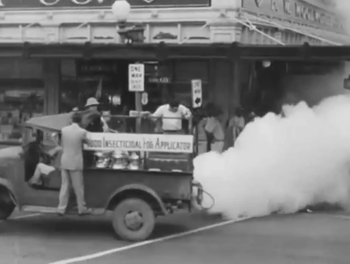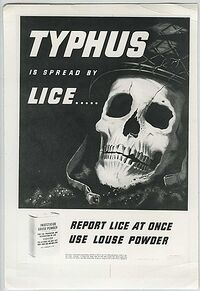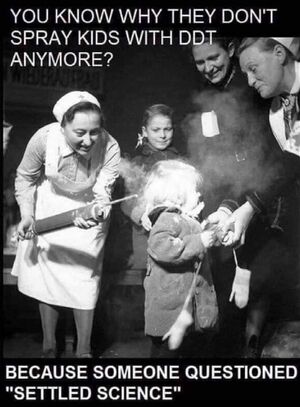Difference between revisions of "DDT"
(start) |
(-) |
||
| Line 3: | Line 3: | ||
|constitutes=Safe and Effective, Pollutant | |constitutes=Safe and Effective, Pollutant | ||
|image=DDT.webp | |image=DDT.webp | ||
| + | |image_width=350px | ||
|description=Originally developed as an insecticide, thanks to ineptitude (and possibly corruption) used without second guesses as to what it's health impacts may be. | |description=Originally developed as an insecticide, thanks to ineptitude (and possibly corruption) used without second guesses as to what it's health impacts may be. | ||
}} | }} | ||
'''Dichlorodiphenyltrichloroethane''', commonly known as '''DDT''', was developed as the first of the modern synthetic insecticides in the [[1940s]]. The substance is known to be very persistent in the environment, will accumulate in fatty tissues and can travel long distances in the upper atmosphere. It was used to combat malaria, typhus, and the other insect-borne human diseases among both military and civilian populations.<ref>https://www.epa.gov/ingredients-used-pesticide-products/ddt-brief-history-and-status</ref> | '''Dichlorodiphenyltrichloroethane''', commonly known as '''DDT''', was developed as the first of the modern synthetic insecticides in the [[1940s]]. The substance is known to be very persistent in the environment, will accumulate in fatty tissues and can travel long distances in the upper atmosphere. It was used to combat malaria, typhus, and the other insect-borne human diseases among both military and civilian populations.<ref>https://www.epa.gov/ingredients-used-pesticide-products/ddt-brief-history-and-status</ref> | ||
| + | [[File:DDT-3.jpg|thumb|left|200px]] | ||
[[File:DDT-2.jpg|thumb|right|300px]] | [[File:DDT-2.jpg|thumb|right|300px]] | ||
When evidence of DDT's environmental and toxicological effects mounted, the U.S. Department of Agriculture (the federal agency with responsibility for regulating pesticides before the formation of the U.S. Environmental Protection Agency in 1970) began regulatory actions in the late [[1950s]] and [[1960s]] | When evidence of DDT's environmental and toxicological effects mounted, the U.S. Department of Agriculture (the federal agency with responsibility for regulating pesticides before the formation of the U.S. Environmental Protection Agency in 1970) began regulatory actions in the late [[1950s]] and [[1960s]] | ||
Latest revision as of 01:14, 24 September 2022
(Safe and Effective, Pollutant) | |
|---|---|
 | |
| Originally developed as an insecticide, thanks to ineptitude (and possibly corruption) used without second guesses as to what it's health impacts may be. |
Dichlorodiphenyltrichloroethane, commonly known as DDT, was developed as the first of the modern synthetic insecticides in the 1940s. The substance is known to be very persistent in the environment, will accumulate in fatty tissues and can travel long distances in the upper atmosphere. It was used to combat malaria, typhus, and the other insect-borne human diseases among both military and civilian populations.[1]
When evidence of DDT's environmental and toxicological effects mounted, the U.S. Department of Agriculture (the federal agency with responsibility for regulating pesticides before the formation of the U.S. Environmental Protection Agency in 1970) began regulatory actions in the late 1950s and 1960s
The publication of Rachel Carsons Silent Spring in 1962 stimulated widespread public concern over the dangers of improper pesticide use and the need for better pesticide controls.
In 1972 the EPA issued a cancellation order for DDT
A DDT victim on Wikispooks
| Title | Description |
|---|---|
| Turgut Özal | 1990s Turkish president covertly assassinated by deep state forces |

